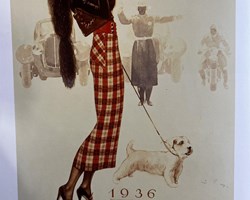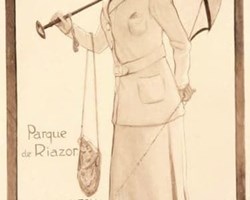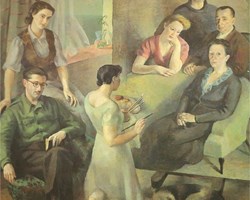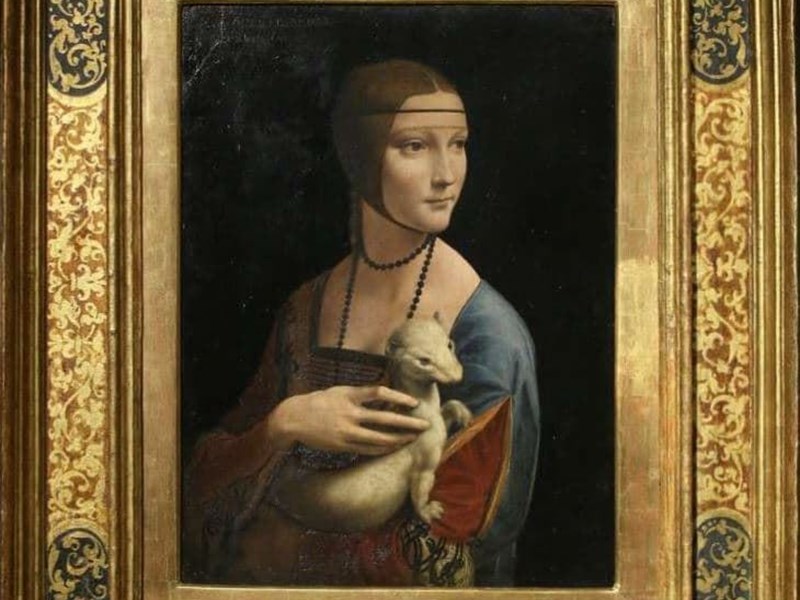
Painting is one of the oldest arts and an attempt by the human being to create beauty and transcend time.
The portrait is a window to the past, it can tell us a lot about a time, a society and a specific person.
Because, who is the beautiful young woman in the painting popularly known as The Lady with an Ermine? How did it come to be portrayed by one of the greatest geniuses in history, the great Leonardo Da Vinci?
She may seem like an anonymous girl, but she has a first and last name: her name was Cecilia Gallerani and like any of us, she had life, spirit and dreams.

THE LADY WITH THE ERMINE.
This portrait was painted by Leonardo Da Vinci at the court of Milan when he moved from his native Florence, approximately in the year 1487 (he was about 35 years old).
At that time Milan was a city willing to prosper at any cost.
It had about 80,000 inhabitants and was an old-style feudal city-state, ruled by a dynasty whose power was based more on force and army than on laws.
Their rulers were the Sforza, who had recently become nobles.
Their origin was military and for some they were patient and cunning heroes who made themselves and for others, just ordinary soldiers.
The one who commissioned the portrait was Ludovico Sforza, his protector and strong man from Milan, as he was keen to create a Milanese renaissance.
He was also nicknamed El Moro, partly because of his dark complexion and partly because of a play on words with one of his names: Mauro.
Ludovico Sforza considered that his subjects were at his entire disposal.
Any woman she laid her eyes on knew that favor was equivalent to a passport to a world of comforts and privileges that not only she, but her entire family, would enjoy.
Cecilia Gallerani was one of the lovers of the Moor.
His father was a high official (he had served as an ambassador in Florence) and his mother was the daughter of a famous doctor of laws.
He had six other siblings and his father died when he was 7 years old.
He was from a good family, though not excessively rich.
She was smart and educated, and even ended up protecting writers.
She had a seductive beauty, we can deduce it from the many poems and letters that were written about her.
We do not know when she became the Moor's lover, but it can be assumed through a document dated June 1487, which formally frees her from a marriage contract contracted during her childhood with Giovanni Stefano Visconti; it is very likely that Ludovico's interest was the reason for that breakup.
Cecilia was only 15 years old.
By the early summer of 1489 he was no longer living with his family, but on an unspecified property in the parish of Nuovo Monasterio, which it is hard to resist identifying as a love nest.
In that same year, his brother Nigerio killed a man in the course of a fight and escaped justice thanks to the personal intervention of Ludovico.
Although Cecilia's wedding plans could be cancelled, Ludovico's were a separate matter.
Since 1480 he had been engaged, for solid political reasons, to the daughter of the Duke of Ferrara, Beatrice d'Este, and the time was approaching to solemnize the marriage: an important dynastic alliance that was to be celebrated with an extraordinary display of the ability of the Milanese for the celebration of big parties.
On November 8, 1490, the Duke of Ferrara received a disconcerting dispatch from his ambassador in Milan, Jacopo Trotti, who informed him that Ludovico's intentions regarding the Madonna Duchessa nostra (that is, Beatrice) were not clear, since who was still madly in love with quella sua innamorata (of Cecilia).
"He has her with him in the castle, he takes her everywhere and wants to give her everything. She is pregnant and as beautiful as a flower, and he sometimes takes me to visit her."
The wedding of Lodovico and Beatrice was celebrated as planned and in all sumptuousness on January 16, 1491, but Cecilia continued to exert her fascination and a month later Ambassador Trotti reported that the Moor had whispered to her that " I wish he could go to La Rocca (his private rooms in the castle) to make love to Cecilia and be with her in peace, and this was what his wife wanted too, because she didn't want to give in to him."
Apparently Beatrice refused to sleep with Ludovico as long as he maintained his relationship with Cecilia.
On March 21, Trotti reports that Ludovico has ordered his lover to leave the castle: "He doesn't want to have sex with her again now that she's so big, and he won't do it until she has given birth to her son."
On May 3, 1491, Cecilia gave birth to a boy.
At the baptism he was given the name Cesare Sforza Visconti.
To celebrate it, the poet Bellincioni composed a trio of sonnets in honor of Cecilia.
To Bellincioni we owe the first reference to Leonardo's painting, in a sonnet dedicated to nature:
"Oh, Nature, how you envy Vinci,
that has painted one of your stars,
the beautiful Cecilia, whose beautiful eyes
sunlight turn into dark shadow.
Well think: the more lively and beautiful
you will have greater glory in future times.
Give thanks, then, to Ludovico
and to the genius and hand of Leonardo,
who want to share it with posterity".
It includes a sharp observation: Con sua pictura / La fa che par che ascolti e non favella ("With her art, she makes it seem as if she is listening and not speaking"), words that partly reflect the serenity of the portrait: Cecilia seems attentive to something that happens beyond the closed space of the painting.
Do they also contain a personal observation about Cecilia: e non favella, that is, for once she is not prattling?
This is the background of the painting: sex, rumors and poetry in the court of the Sforza.
Cecilia's portrait has an erotic content: the hand that caresses the animal is a sexual allusion.
The accessories of the dress: the gold band on the forehead, the black ribbon, the hair and the necklace, suggest the condition of the subject woman, of the captive, of the concubine.

Leonardo argues that the painter has the same power as the poet to "inflame men with love" by making them "fall in love with a painting".
And tells the following story:
"It happened to me on one occasion that having made a painting that represented a divine figure, it was bought by a man who fell in love with her and wanted me to erase the emblems of divinity so that he could kiss her without scruples. But finally his conscience prevailed over his sighs and desires and was forced to remove the painting from his house.
The animal that the young woman holds in her arms contributes to the work a series of symbolic and folkloric associations.
It is an ermine (Mustela erminea), of the northern or winter variety, characterized by the whiteness of its skin (although the painting is colored by the varnish and appears yellowish).
This animal was associated with purity and cleanliness, as we read in Leonardo's "bestiary" compiled in the early 1490s:
"The stoat, because of its temperament... prefers to fall into the hands of hunters rather than take refuge in a den full of mud, so as not to get dirty." The ermine also appears as a symbol of purity in the portrait of a gentleman painted by Vittore Carpaccio around 1510, in which a legend placed over the animal reads: Malo mori quam foedari, ("I'd rather die than be sullied").
This association with purity adds a partially ironic refinement to Cecilia's portrait: the symbolic opposed to the erotic.
But the ermine offered a more specific meaning.
It was an emblematic allusion to Ludovico himself: in 1488, Ferrán de Aragón, King of Naples (grandfather of Isabel de Aragón) had invested him with the Order of the Ermine.
The animal that we see on Cecilia's arms is, therefore, an emblem of the man to whom she is socially and sexually united.
You can see his watchful gaze, his strong muscular leg and his claws extended on the young woman's red sleeve.
As he often does, Leonardo represents the emblematic so strongly that this reverts to the real, so that we see the stoat as a predator, what it is in nature and what Ludovico was.
Both stoats and their relatives (weasels, martens, ferrets, etc.) were used as pets, so the portrait, taken as a whole, is not fantastic: it achieves a special resonance with its beautifully lit, almost photo-realistic image. on a black backdrop.

Although rejected, Cecilia continued to be the object of the Moor's affection and, as the mother of one of his natural children, continued to receive favors at his hand.
Ludovico granted him some land in Saranno, north of Milan, and in 1492 he married a Cremonese, Count Lodovico Bergamini.
Cecilia kept a small salon in the Palazzo Carmagnola in Milan; Among those who paid him homage there was the author Matteo Bandello, who dedicated two of his novellas to him and praised him for his wit, erudition, and Latin verse.
Cecilia remained in possession of her portrait, and on April 26, 1498, the insatiable collector Isabella d'Este sent her a request in a peremptory tone, although not unpleasant if we take into account that she was Beatrice's sister:
"We were looking at some beautiful portraits painted by Zoanne Bellino (Giovanni Bellini) today when we started discussing Leonardo's works and wishing we could see some of them to compare with the ones we have here. We remember that Leonardo painted a portrait of you from life, would you be so kind as to send it to me by means of the bearer of presents that I am sending you for this purpose? In addition to serving to carry out such a comparison, it would give us great pleasure to see your face. As soon as we have studied it, we will return it to you."
On April 29, Cecilia replied that she was sending him the portrait,
"...although I would be more than happy to send it if it were more like me. Your lordship must not think that this is due to any error on the part of the master, which I sincerely consider to be without equal. It is only because the portrait was painted when my age was imperfect and my face has changed completely since then, so that if the portrait and I were put together, no one would think that it was me represented".
This was by no means the last of the portrait pilgrimages.
After Cecilia's death in 1536, he remained in Milan.
In the 18th century it could still be seen in this northern Italian city in the collection of the Marquises of Bonasana.
Around 1800, the painting was bought by a Polish prince, Adam Jerzy Czartoryski, who gave it to his mother Isabella, who hung it in her painting gallery, called the Gothic House, near Krakow.
In 1842, the Czartoryski family lived in exile in Paris and kept the painting, which remained in that city for 30 years, in the family residence of the Hotel Lambert, although there was no news of it in French artistic circles.
After the Franco-Prussian War the family returned to Poland, and in 1876 the Lady with an Ermine was exhibited for the first time in the Czartoryski Museum in Krakow.
During World War II he ran his last adventure.
In 1939, shortly before the German invasion of Poland, it was hidden in Sieniawa along with other treasures from the Czartoryski collection: a landscape by Rembrandt and a portrait by Raphael, but was discovered.
It was briefly exhibited at the Kaiser Fridrich Museum in Berlin and later reserved for Hitler's private museum in Linz.
It eventually ended up in the private collection of the Nazi governor of Poland, Hans Frank, in whose Bavarian villa it was discovered in 1945 by the Polish-American committee.
Thus the vicissitudes of love and war have marked this small walnut table (40.3 cm wide and 54.8 cm high) that left Leonardo da Vinci's studio around 1489.
* Information taken from the book "Leonardo: the flight of the mind", by Charles Nicholl.

THE SECRETS OF THE LADY OF THE ERMINE:
Using innovative techniques, the Lumière Technology company discovers the secrets hidden in the famous work of Leonardo da Vinci.
French engineer Pascal Cotte, founder of Lumière Technology, a company dedicated to researching works of art using reflective light techniques, has managed to penetrate the secrets of one of Leonardo da Vinci's most emblematic paintings: Lady with an Ermine.
The oil, painted in 1490, is the portrait of Cecilia Gallerani, mistress of Ludovico Sforza, Duke of Milan.
After studying the painting for three years, Cotte was surprised to find that the ermine that gives the work its title was not always there, but was added later.
First the brilliant artist painted Cecilia alone, and later added the ermine; but not happy with the appearance of the animal the first time, he repainted it later.
READ BETWEEN LAYERS:
For the study of the work, Cotte has used a technology of her own invention that she has dubbed the "layer amplification method".
This technique offers the possibility of "peeling" a painting as if it were an onion, extracting the layers until reaching the last one and observing what is hidden between them.
The method consists of projecting a series of intense lights on the canvas and then a camera measures the reflections of the lights.
Based on these measurements, what is between one layer and another, in this case of Leonardo's famous work, can be analyzed and reconstructed.
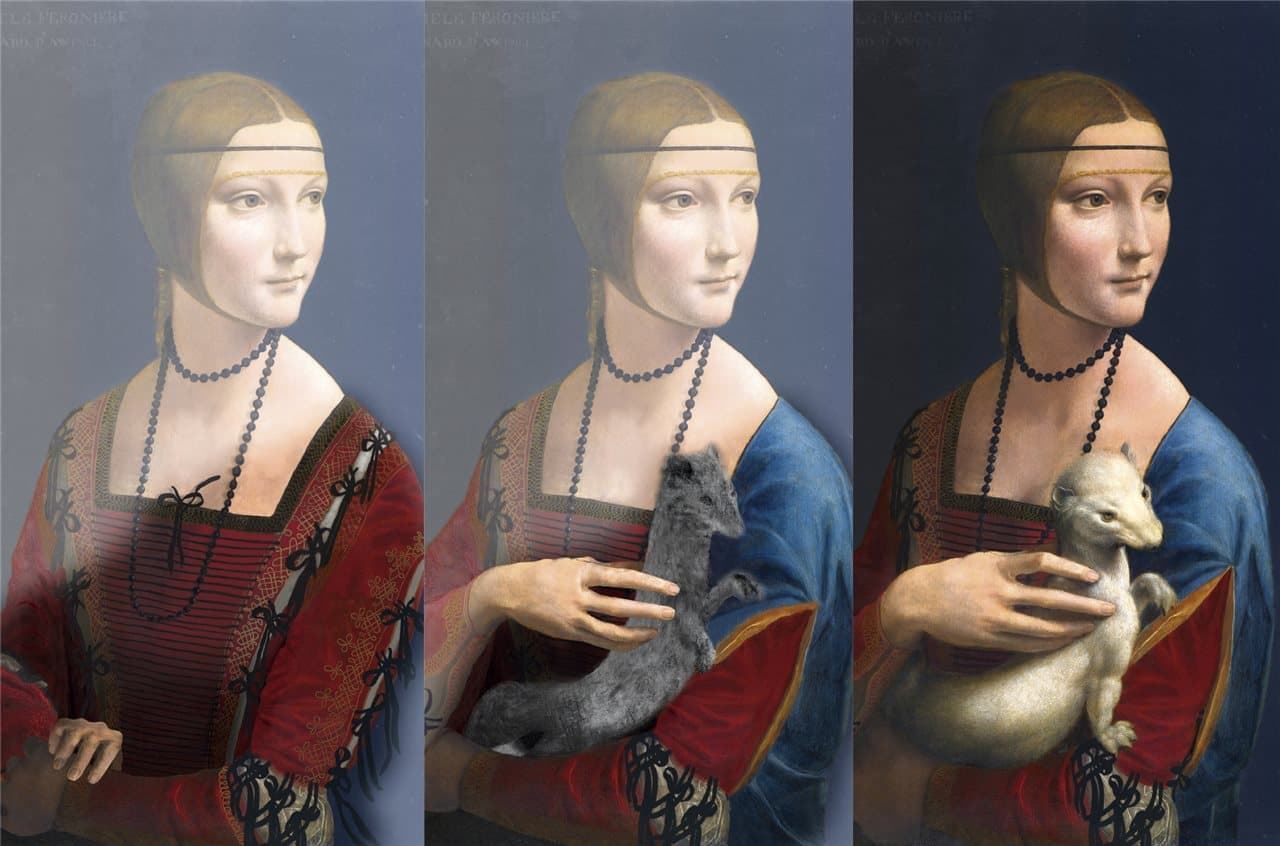
POLAND BUYS "LADY WITH AN ERMINE", A PRICELESS WORK BY LEONARDO DA VINCI:
The secret negotiation with the State caused strong tensions with the Foundation's Polish board of directors, which reacted by resigning.
AFP, by Stanislaw WASZAK, "The Lady with an Ermine", one of the four known female portraits by Leonardo da Vinci, passed into the hands of the Polish State, on December 26, 2016, in an operation that included the entire Czartoryski collection for barely one hundred million euros, several times lower than its real market value.
"It is with great emotion that I can declare that we all, citizens of the Polish Republic, are now owners of the Czartoryski collection," Piotr Glinski, Polish Minister of Culture, congratulated Prince Adam Karol Czartoryski.
The true value of the collection, which contains tens of thousands of objects, including Rembrandt's "Landscape with the Good Samaritan", is difficult to estimate and could exceed $2.09 billion.
Only "The Lady with an Ermine" is insured for more than 350 million, according to the media.
Following confidential negotiations between the Ministry of Culture and the Czartoryski Foundation, the collection, which includes the painting painted in Milan in the late 15th century, changed hands in an official ceremony at the Royal Castle in Warsaw.
The transaction on the collection, the buildings in Krakow that belonged to the foundation and the claims on the missing pieces and eventually found in the future, was made as a "sale and donation", the minister specified.
"In life you do what you want. I wanted to make a donation and it is my choice," said Prince Czartoryski when asked about the low price of the transaction.
This collection, one of the oldest and most precious in Europe, was founded in 1801 by Princess Izabela Czartoryska to collect and preserve Polish and European works of art when her country was divided and occupied by three neighboring powers.
Since the fall of communism, it belonged to the Czartoryski Foundation, founded and chaired by Prince Adam Karol Czartoryski, and has its official residence at the National Museum in Krakow.
The government seeks to ensure that the collection never leaves Poland, a possibility that existed while it belonged to the foundation.
The 76-year-old prince's heirs have no direct ties to the Central European country.
"The culture minister's intention is... to keep it in Poland for future generations," the ministry said in an email to AFP.
The secret negotiation with the State caused strong tensions with the Foundation's Polish board of directors, which reacted by resigning.
"The council did not participate in the talks, did not have any influence on the drafting of the contract or on the decision on the future of the institution after its sale to the Public Treasury, nor on the determination of its sale price which, according to what it says the press, greatly deviates from the real value" of the collection, lamented its resigning president, Marian Wolkowski-Wolski.


